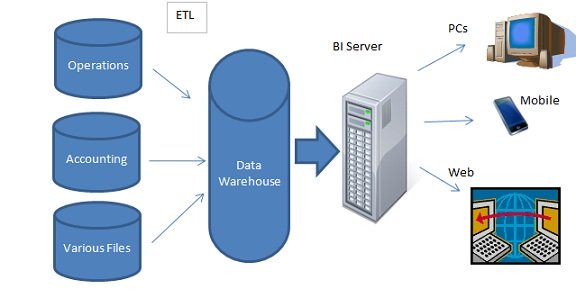BI Architecture
BI architecture is a critical piece of the overall business intelligence implementation. The technical side of an installation and rollout should not be ignored. Done right, it will provide quick and easy access to users for critical data. Done wrong, it can seriously curtail the project. It usually involves several different pieces of technology, including data warehouse, portals, and software. The diagram below attempts to show a high level, best practice type of implementation.

A typical setup will start by accessing the different data sources that will be needed for the system. This usually can cover various areas of the company’s activity, from operations, to accounting and payables, marketing, and any other internal data marts. In a standard, best practice layout, these sources will be consolidated into a business intelligence data warehouse. ETL is used to convert the varying data types into a single version of the truth. This source is normally the sole source of a BI system. The server or central admin tool will then generate the appropriate reports, dashboards and objects for the numerous ways consumers can access the data. The main point of contact are generally PCs, mobile devices, or the general web but can include other devices, like printers or other enterprise systems.
Additionally, a BI server infrastructure will usually contain a web administration, and sometimes a mobile configuration as well. The growth of cloud based systems also throws another possibility into the ways of implementation. Still, this diagram is a way to show the overall setup for a enterprise wide BI architecture.
Granted this layout is a generalized version. In reality, it can be difficult to consolidate all data sources into one central point. So the BI tool may need to operate outside of the DW environment on occasion. In some cases, there might not be a DW at all, or it may not be ready by the time reporting requirements are due. Most vendors are recognizing this need and building options for multisource capabilities, and diverse data sources, even Excel. This flow chart assumes a great deal of IT involvement, which might not be available either. In certain cases, all of the work might be done on a local PC, such as with Qlikview Personal. Overall, I think the push from organizations will be for more flexibility in sourcing and delivering data, away from a forced big budget IT installation.
Get more information about Architects
Copyright 2011-2022 BusinessIntelligenceBase.com